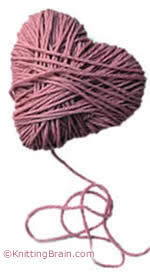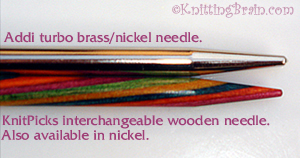 Scroll down for information on :
Scroll down for information on :
1. Knitting Needle Sizes
2. Straight versus Circular Knitting Needles
3. Buying Knitting Needles
4. Wooden, Metal and Plastic Knitting Needles
5. Knitting Needle Point Styles
1. Knitting needle size conversion:-
UK /Canadian / US / mm
The table below shows the equivalent knitting needle sizes in UK, Canadian, US and metric.
|
UK & Canadian Size
|
Metric Size in mm
|
USA Size
|
|
14
|
2.0
|
0
|
|
13
|
2.25
|
1
|
|
12
|
2.75
|
2
|
|
11
|
3.0
|
–
|
|
10
|
3.25
|
3
|
|
–
|
3.5
|
4
|
|
9
|
3.75
|
5
|
|
8
|
4.0
|
6
|
|
7
|
4.5
|
7
|
|
6
|
5.0
|
8
|
|
5
|
5.5
|
9
|
|
4
|
6.0
|
10
|
|
3
|
6.5
|
10.5
|
|
2
|
7.0
|
–
|
|
1
|
7.5
|
–
|
|
0
|
8.0
|
11
|
|
00
|
9.0
|
13
|
|
000
|
10.0
|
15
|
2. Straight versus Circular Needles
- Circular needles can be used for knitting flat or in the round
- Circular needles can be used for any pattern that uses double pointed needles
- The choice of straight vs circular needles depends on your personal knitting style
Let me admit it now, I love circular knitting needles. (I'm also a fan of top down knitting patterns, so circular needles are ideal for me.)
My knitting needle collection is almost exclusively circular needles for sizes above 3mm. The rest of my needle collection is small sized double pointed needles that I use mainly for making socks.
The trick is to try out straight and circular needles for knitting flat and also try circular needles vs double pointed needles for knitting in the round. Find out what suits you. I have found that I like small double pointed needles for knitting socks but I prefer circular needles for anything larger and for knitting flat.
Good quality circular needles (and I stress good quality) are a joy to work with. The bulk of the weight of your knitting rests on your lap, the shorter needle tips are very comfortable to hold, you can use them for straight or circular knitting and you don't end up losing one of your needles down the side of the sofa! There are even bamboo sharp tipped circular needles available for lace knitting.
 I use Addi turbo circular needles and KnitPicks interchangeable circular needles, both shown below. I would recommend any knitter to try them in place of straight needles. A set of circular needles will prove more versatile than a set of straight needles, so there is a money saving aspect too. If you've been unimpressed with circular needles in the past then you will be pleasantly surprised, these needles are beautifully made and the stitches slide effortlessly from the cord to the needle tip.
I use Addi turbo circular needles and KnitPicks interchangeable circular needles, both shown below. I would recommend any knitter to try them in place of straight needles. A set of circular needles will prove more versatile than a set of straight needles, so there is a money saving aspect too. If you've been unimpressed with circular needles in the past then you will be pleasantly surprised, these needles are beautifully made and the stitches slide effortlessly from the cord to the needle tip.
I find the 60cm / 24 inch and the 80cm / 32 inch length circular needles the most versatile. If you are knitting in the round it is amazing how many stitches you can comfortably fit on the needle. The problem is if your needle is too long requiring the knitting to be stretched, this distorts the knitting and makes it hard to move the stitches around the needle.
 If you have 2 circular needles you can do circular knitting of any size which means you don't need to resort to double pointed needles even for knitting socks. Alternatively you can use the Magic Loop method to use a single long circular needle for small diameter circular knits.
If you have 2 circular needles you can do circular knitting of any size which means you don't need to resort to double pointed needles even for knitting socks. Alternatively you can use the Magic Loop method to use a single long circular needle for small diameter circular knits.
I have even been known to knit i-cord on circular needles, it's a little slower than on shorter double pointed needles but I can't see the point of buying double pointed needles just for the rare occasions when I want to make an i-cord.
Admittedly they're not quite as pretty to look at as some of the beautiful straight knitting needles that are available. While I use mainly nickel plated needles, I do have real affection for the look and feel of wooden needles. Most of my double pointed sock knitting needles are wood or bamboo.
Knitting with 4 or 5 double pointed needles also looks far more impressive than using circular needles. But, if your vanity can bear it then circular knitting needles are well worth trying.
3. Buying Knitting Needles
Sadly many knitting shops in the UK stock the most horrible knitting needles! You will enjoy knitting far more with a nice set of needles.
 The poor quality needle at the top of the photo was actually more expensive than the high quality Addi turbo needle shown at the bottom.
The poor quality needle at the top of the photo was actually more expensive than the high quality Addi turbo needle shown at the bottom.
I've already confessed my love of Addi turbo and KnitPicks circular knitting needles, but if you want straight needles then there is plenty to choose from.
It is worth investing in a good quality needle size gauge too as sometimes needles aren't the size they claim to be or the size label wears off with use.
4. Wooden, Metal and Plastic Knitting Needles
If you knit tightly go for a very smooth material such as aluminium.
Wooden needles are generally pleasant to work with. They are warm to the touch and lighter than metal. You can get rosewood, ebony, bamboo and birch needles all from sustainable sources.
If you plan to use double pointed needles you may find bamboo or wooden needles easier to use. They are less heavy and less slippery than metal needles so they don't tend to slip out of your work at inopportune moments.
Plastic knitting needles tend to be light weight and somewhere between wood and metal in terms of smoothness. They come in a fabulous array of colours but again look for quality. Some plastic needles have a nasty ridge running the length of the needle where it hasn't been properly finished. This will snag the yarn and make knitting slower.
The down side of plastic needles is they tend to be a bit brittle so they can snap.
As your stash of knitting needles grows (and it will!) you'll be able to match the knitting needle to the yarn. So for slippery fibres such as silk you may well find that the extra grip provided by bamboo or wooden knitting needles makes knitting easier. Smooth metal needles make fibres such as hemp easier to work.
5. Point Styles
If you tend to help the stitches off your needle by pushing on the point of the left needle then look for blunt ended needles.
If your stitches tend to be very tight on the needle then the point style of your needles could be to blame. Needles with a long taper make it more likely that you will be forming your stitches on the thinner part of the needle rather than on the shaft of the knitting needle (see the photo above). The result is that when the stitches are moved onto the main shaft of the knitting needle they are too tight. A blunt ended needle style might help solve the problem.
If you just naturally knit very tightly, and you really can't learn to loosen up then go for more pointed ends. The sharper pointed ends can also come in handy for lace work.